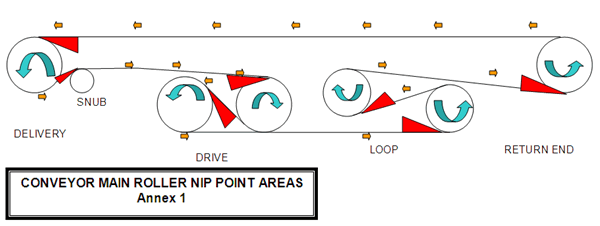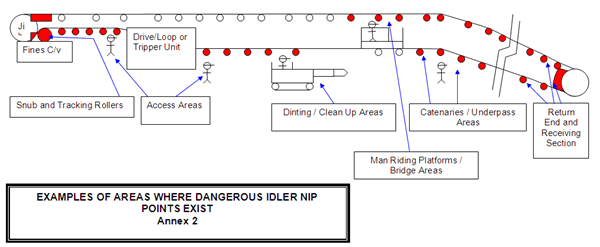Belt Conveyor Fatal Nip Hazards
SPC/Tech/SI1/11
Purpose
This circular highlights the hazards associated with belt conveyor nip points that are exposed or can become exposed to people when conventional peripheral guards are removed.
A recent accident and inspections at mines have indicated that these hazards are not always being recognised, and serious injuries or fatalities could be repeated in an industry that has killed or seriously injured many people in the past through unguarded nip points.
Definition
A nip point is the dangerous pinch point which occurs at the line of contact between the rotating drum or roller and the moving conveyor belt on the in-running side of the drum or roller. A diagram showing these locations on a conveyor belt are shown at Annex 1, and Annex 2.
Note:
A similar point on the out-running side of the drum or roller where the conveyor belt exits is not the dangerous location, unless the conveyor can be reversed. This is important because in some cases it is difficult to identify the nip point side, for example, in some conveyor loop take-up systems.
Background
The mining industry has a long history of accidents and fatalities arising from 'nip hazards' on belt conveyor systems. Over the last 40 years or so, a policy has evolved on nip point guarding the main system rollers and idlers at dangerous locations. It was in 1968 when the NCB first introduced delivery end nip guards following a number of fatal accidents. The dangers associated with idler nip hazards on heavy duty belt conveyors is addressed in a separate circular first published in 2002 (SPC/TECH/S15/05).
The process of adopting nip point guarding as well as peripheral guarding has been progressive, usually in response to an accident resulting from ineffective or missing peripheral guards. The conveying of coal or other mineral often results in the accumulation of fines and spillage requiring the removal of peripheral guards which are often not replaced to their original standards resulting in exposure of unguarded nip points. Additionally, because of the constricted nature of most underground and some surface locations, people are often very close to or passing below operating conveyors.
The success of adopting nip point guards as well as peripheral guards at vulnerable positions on belt conveyor systems has been demonstrated over many years by the fact that nip point accidents have been eliminated where the nip points have been effectively guarded.
Hazard Locations
Hazardous nip points may occur at the following locations:
- Drive drums
- Terminal rollers at delivery and return end locations
- Bend and snub rollers
- Loop take-up rollers
- Transition troughed idlers adjacent to main rollers
- Carrying and return idlers at convex curves
- Carrying and return idlers beneath feed hoppers, skirt plates and where the lift of the belt has been restricted
- Roller assemblies for conveyor belt tracking
- Locations affording access to persons eg bridges or underpasses, maintenance / storage areas, dinting / cleaning areas
Risk Assessment
Research in the extractive industries has shown the need to assess human factors associated with the operation, use and maintenance of conveyor systems.
Some take the view that peripheral guarding alone is adequate to control the risks from nip points and that conveyors should not be allowed to operate unless these guards are fitted. Unfortunately accident experience in the mining industry clearly shows that peripheral guard removal is often necessary to allow cleaning and maintenance. This results in the exposure of the nip point during the cleaning and maintenance operations and during normal operation of the conveyor, as guards are often left off at locations where they have to be frequently removed. Previous initiatives have involved improved peripheral guard fixing arrangements and/or emergency stop cables interlinked with the guards. However, none have proved as successful as nip guards fitted directly at the nip points. Nip guards permit visual inspection during conveyor operation and cleaning and maintenance work to be carried out without removing the nip guard. They offer the most reliable form of continuous protection for dangerous nip points.
Legislation
Two of the most relevant parts of health and safety legislation dealing with risk assessment are:
- Regulation 4 of The Management of Health and Safety at Work Regulations 1999
- Regulation 11 of The Provision and Use of Work Equipment Regulations 1998
Both require a hierarchical approach to be used. The priority should be to eliminate the nip hazard at source. Where elimination is not possible, effective guarding should be used. Nip guards provide the best solution, because they protect the nip point directly and they do not normally require removal.
Instructions given to employees not to operate a conveyor without the fitting of peripheral guards, is further down the risk hierarchy. It is supplementary to and not a substitute for the provision of effective nip guards at all times.
Regulation 11 of The Provision and Use of Work Equipment Regulations 1998 is very relevant to the provision of effective guards.
- Regulation 11(1) requires effective measures to prevent access to dangerous points.
- Regulation 11(2) provided a hierarchy that primary measures are fixed enclosing guards, and where impractical, other guards.
- Regulation 11(3) requires that guards shall not be easily by-passed or disabled, and be constructed to allow access for necessary maintenance if possible without having to remove them.
In addition, health and safety statute often uses the term 'as far as is reasonably practicable' in this context, nip guards should be fitted where nip hazards are identified unless it can be shown that this is disproportionate to the risk. The use of nip point guards in the industry over many years has shown that to fit them is a reasonably practicable measure, which can be easily achieved and at little cost compared to the overall cost of the belt conveyor.
Nip guards, are essential safety devices and they need to be maintained in effective working order. They are an essential safeguard and should be subjected to a suitable scheme of inspection, examination and maintenance. Each nip guard should be individually identified in such a scheme to ensure that the location of each guard is clearly identified and each has its own record of inspection, examination and maintenance.

